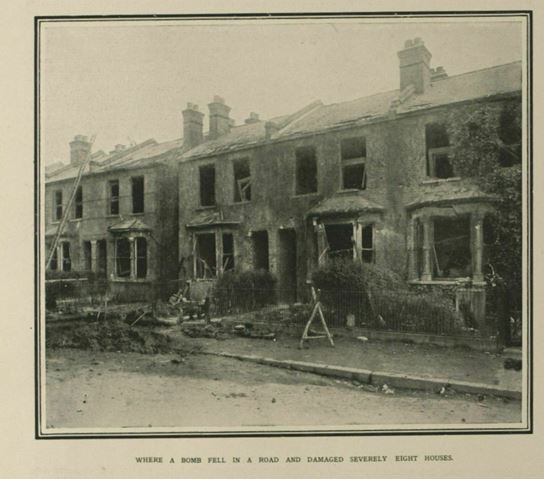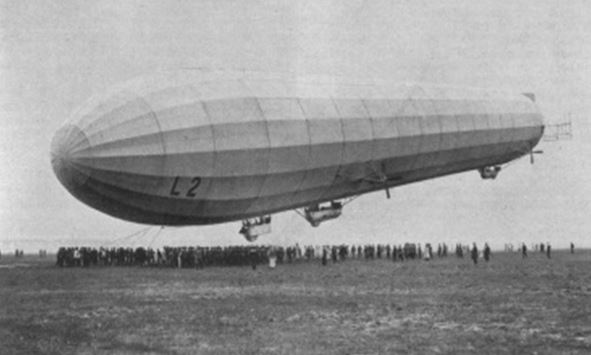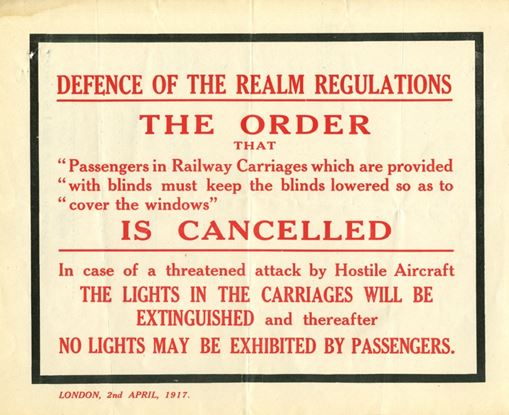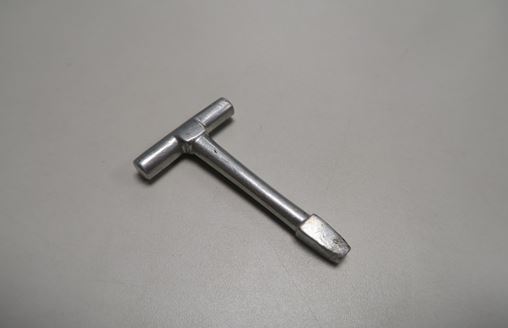
One area of my research that I have found particularly interesting, has been the subject of Zeppelin raids and Black-outs on the railways during the first War. This important and often overlooked part of the war shows that the danger faced by those working on or the railways was not only fighting on foreign soil, but also from the terror of the Zeppelin raids back at home.
The Black-outs of World War Two and the terrible damage and loss of life inflicted by the blitz, are held within the nation’s collective memory most strongly, and we often associate this period as being the time in which the idea of ‘black-outs’ was first conceived. However during the First World War, there was also a need to put out the lights, as German Zeppelin raids commenced on Britain in 1915.
There were over fifty separate Zeppelin raids across the country during the Great War, only coming to an end in May 1918. Although the damage caused by these raids reached nothing like what would be seen in the later Blitz of World War Two, there was still around 300 tons of bombs dropped, resulting in the deaths of 1,414 people, and the injury of many more. There was also wide spread material damage of industrial and port facilities, government and military buildings, as well as civilian properties.
A large proportion of the Zeppelin raids occurred at night, and therefore the need to conceal light was paramount, as any light source would give the enemy a clear target to strike. The government recognised the need to enforce certain measures to secure public safety, and at the beginning of the war, the ‘Defence of the Realm Act’ (DORA) was passed. This act contained, among others, an enforced blackout in certain towns and cities to protect against air raids. The attacks were often indiscriminate, and as such there was little that escaped the wrath of the Zeppelins destruction, including the Railways.

There are numerous accounts of Zeppelin attacks on Britain during World War One, including one account of a Zeppelin raid on London in 1915, and a subsequent fire in a hostelry and other buildings, caused by an incendiary bomb. The Great Western Railway Magazine, November 1915, reports the bravery of the men from the nearby Euston Station, foreman Hannon (an ex solider), who with a bucket of water rushed into a building to put out a fire. Hannon, along with Shipper Tackley, and Checker Yarnall, were able to rescue some of the occupants, and assist the injured until the arrival of the metropolitan fire brigade and an ambulance. The men were complimented by the company for their prompt and courageous conduct. (source: Great Eastern Railway Magazine, November 1915)
Another account of a Zeppelin attack comes from the report of the bombing of Monkwearmoth Train Station. This particular attack occurred on the night of Saturday 1 April 1916, during a raid of Sunderland by a German Imperial Navy Zeppelin.
“When first built there was a roof over the lines between the main building at Monkwearmouth Station and the Goods Yard on the west side. This roof provided shelter for the passengers waiting for their trains. The Zeppelin rained down high explosive and incendiary bombs on both sides of the River Wear. A casualty of the raid was the roof over the railway lines and was never repaired, being removed completely 12 years later in 1928.”
(twmuseums.org.uk – Monkwearmouth station bombed)

The bravery of those who lived through the attacks, and the courage that some showed in the face of severe danger was well recorded. This local account comes from a report of a Zeppelin attack on York on the night of May 2, 1916. Zeppelins dropped 18 bombs on Dringhouses, before heading for the city Centre. There they bombed Nunthorpe Hall Red Cross Hospital and Nunthorpe Avenue, killing a young girl who lived there. WT Naylor, a bricklayer at York Carriage Works and a member of the North Eastern Railway fire brigade, was awarded a medallion by the NER Centre of the St John’s Ambulance Association for “conspicuous bravery” during one of the Zeppelin raids. Mr Naylor’s son was in the army and had been awarded the Military Medal for bravery at the front. In the words of the Lord Mayor of York, this showed that “the family came from the right stock”. (Source: York Press, November 2013).
If you are interested in finding out more about the names and addresses of local railwaymen and their families in York, have a look on our online database mentioned above, and look out for the upcoming app. Also check out all the great work that is being done with schools, and the project based around the First World War and the Ambulance Train.
Although laws were enforced to keep all unnecessary lights out, there were of course exceptions to the rules. Posters were issued to remind civilians that the use of torches, and even bicycle lamps were forbidden. However Ministers decided that the railways were too important to close down, even temporarily. Goods had to be moved, and it was deemed essential for the station to keep functioning. This would be the sad case in the account from Nottingham in July 1916, when German Zeppelin pilots apparently on route to Sheffield, noticed the lights of Midland station shinning like a beacon, whilst the rest of the town was in total darkness. The raid resulted in the deaths of civilians, including Alfred T Rogers, 44, and his wife Rosanna, 43.
It was obvious from this attack, as well as others, that stricter measures needed to be put in place in order to prevent further casualties. An inquest into the attack concluded the following:
“The jury are of the opinion that the city was exposed to the risk of attack by airship entirely by the action of the railway companies in keeping their premises lighted until after the first bombs had been dropped.”
(Nottingham Post)
Strict rules were put in place in order to protect the general public, as well as those working on the railways during the First World War. The Black-out blinds that were introduced on trains to minimise light were cancelled in April 1917, and a severe measure of complete lights out was put into order during enemy Zeppelin attacks on the railways.

However, despite the heavy restrictions, and the looming threat of attack from the skies, there was still room for humour and good cheer. An article from the London and North West Railway (L&NWR) Gazette, November 1916, reports this light hearted take on the newly enforced black-out restriction on the railways;
We should not have though that the familiar official notices exhibited in all railway carriages, at the present time, would have afforded a theme for the poet, but the following, the work of an unknown rhymester, was recently found in one of our express trains.
In view of possible attack
On trains upon the railway track
By hostile Aircraft overhead,
The Government has plainly said
“The Blinds of all trains must be drawn
From sunset glow to early dawn.That no chance ray or spark of light
Shall glimmer through the murky night
Blinds must be drawn completely down
But at a station in a town
The Blinds may sometimes lifted be
In case of great necessity.But when the train goes again
From looking out you must refrain,
For heavy penalties ensue
To him who lets a ray creep through”
Be sure you’re at the platform quite
Before attempting to alight.(London and North Western Railway Gazette Volume 5, November 1916.)
Another light hearted story to come out of the Zeppelin raids comes again from the London and North West Railway Gazette. After a Zeppelin was brought down by Anti-Aircraft Defences in Essex in September 1915, members of the company were able to utilise the aluminium portions of the air craft for manufacturing articles such as toasting forks, pipe racks, ‘iron’ crosses, and other souvenirs.
These articles were sold for the War Seal Foundation (London and North West Railway section), which aimed at providing cheerful homes for London and North Western railway men who were disabled in the war.
It ends with this tantalising sentence:
“Several interesting girder portions will also be available for exhibition.”
(L&NW Railway Gazette, Dec 1916 – vol 6. P347/8)
Our own Warehouse holds a piece connected to a downed Zeppelin. Within our fantastic collection of over 1,000 objects, spanning 300 years of railway history, an interesting item can always be found.

You can find out more at our online fallen railwaymen database.
Very interesting read, just shows that there was at lot of brave people working in Britain as well as the soldiers aboard fighting abroad. Great article
Very interresting. I know somthing about the ZEPPELINER because we live 5 minutes from were they started and landed.
A very good histotry.
Very interesting.
Very interesting. I had no idea this ever happened. Wouldn’t mind a look in that warehouse!
Interesting write up! How do I find out more about the railways!
Cracking stuff,
love the poem found by the Unknown rhymester.
thank you for posting these stories, so many stories will never be heard
Great article. It’s fantastic to see that the lesser known details of British railways are being brought into relief. Thanks.
Thank you for sharing this! I am curious to know what other souvenirs were created from the downed Zeppelin(s).
Great article – the information from the York Press article was from an article by myself relating to my book ‘The North Eastern Railway in the First World War’ which covers raids on the NER by air and sea in the First World War. Happy to discuss the role of the NER in the First World War further with anyone interested
Our family lore has it that my great-grandfather, Bill Bonser, was a locomotive driver and after realizing that his train was being followed by a Zeppelin, decided to hide the train in a tunnel for a period of time. Interesting idea, but I only have my grandmother’s account to go by.